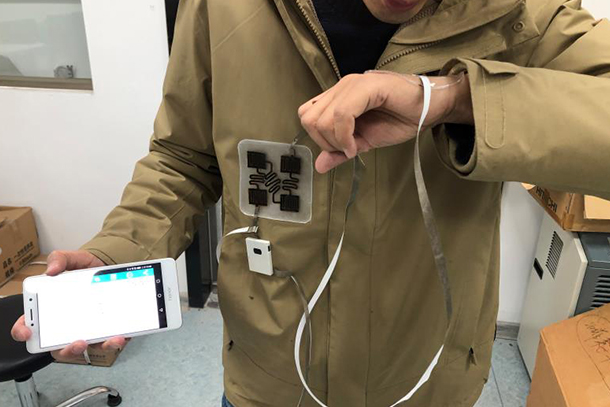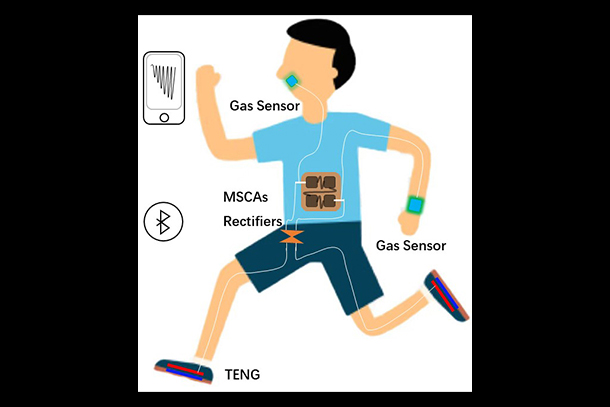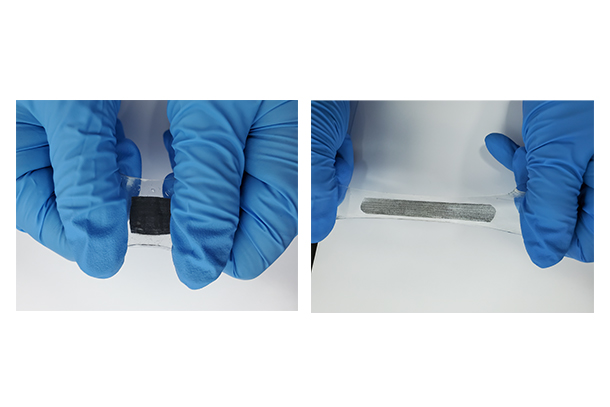
A Penn State-led research team developed a standalone system to monitor nitrogen dioxide in exhaled breath and in the environment. Fabricated from the same nanocomposite material, the self-powered system stretches to adhere to skin or clothes. Credit: Provided by Huanyu "Larry" Cheng/Penn State. All Rights Reserved.
Standalone sensor system uses human movement to monitor health and environment
April 12, 2023
By Ashley WennersHerron
UNIVERSITY PARK, Pa. — For mere dollars, a Penn State-led international collaboration has fabricated a self-powered, standalone sensor system capable of monitoring gas molecules in the environment or in human breath. The system combines nanogenerators with micro-supercapacitors to harvest and story energy generated by human movement.
The researchers published their approach, which costs up to just a few dollars for materials and uses widely available equipment, last week in Nano Letters. The development is the culmination of years of work led by corresponding author Huanyu “Larry” Cheng, James L. Henderson Jr. Memorial Associate Professor of Engineering Science and Mechanics at Penn State.
“This is a really a combination of previous studies where we’ve continued the journey of developing wearable gas sensors,” Cheng said. “Most sensor research and development centers on the fabrication of device materials. Here, we’ve used one material to produce multiple components on a single platform that work together as a standalone system.”

The standalone system converts energy from human movement, like running) to power gas sensors at the mouth and wrist, as well as to send data via Bluetooth. Credit: Provided by Huanyu "Larry" Cheng/Penn State. All Rights Reserved.
Cheng and his team previously developed sensors to detect nitrogen dioxide, which can indicate various pulmonary diseases in exhaled breath, and other gases that may signal poor environmental air quality. They also invented a laser-induced graphene foam material with MXenes, or two-dimensional transition metals that are less reactive than other metals. The novel material and new fabrication method make for a stretchy sensor that can bend with human movements. The researchers also applied this approach to produce stretchable micro-supercapacitors that can store energy produced by those human movements.
In this paper, the group combined these efforts. They first applied a laser to previously developed 3D porous graphene foam on a flexible substrate. Next, the researchers sprayed MXenes on the graphene foam and used another laser to combine the foam and MXenes into a nanocomposite material. They then transferred the nanocomposite material to a pre-strained elastomer, which they slowly released. This slow release crumples the nanocomposite, which can be patterned differently for sensors, nanogenerators and micro-supercapacitors.

The crumpled nanocomposite foam can maintain its ability to operate even when stretched up to 300% of its resting state. Credit: Provided by Huanyu "Larry" Cheng/Penn State. All Rights Reserved.
“Using this laser is almost like toasting a piece of bread: it changes the surface of the bread into something more stable,” Cheng said, explaining the laser uses carbon dioxide to change the material’s surface. “You end up with a more stable and porous product than what you started with. This material enables more sensitivity in the sensors and more conductivity in the other components.”
The lasers used are available in most machining shops, according to Cheng.
“These materials are cheap, and the more expensive tools are widely available — Penn State alone has hundreds of these lasers,” said co-corresponding author Cheng Zhang, who is affiliated with Minjang University in China and was a visiting scholar in Cheng’s lab. “With the low-cost and wide availability of materials and tools, this approach could certainly be scaled up for use in the clinical setting.”
With the same nanocomposite material comprising each device, the components of the system work together seamlessly, according to Cheng. Since the 3D nanocomposite foam was pre-strained, creating the “crumpled” effect, each component can also be stretched and bent to adhere to human skin or clothing without losing sensitivity.
“The improved electrical conductivity, mechanical robustness and specific surface area of the crumpled porous graphene/MXenes from the simple fabrication provide opportunities for applications in the standalone stretchable device platform,” Zhang said.
To demonstrate proof-of-concept, a research associate wore gas sensors under their nose and on their wrist, as well as nanogenerators on their shoes and an array of micro-supercapacitors on their shirt. The person exercised vigorously, with the nanogenerators harvesting energy produced by their foot movements. That energy was stored by the micro-supercapacitors, which used the power to collect and send data from the gas sensors to a Bluetooth receiver, where the scientists could analyze it. The sensors continuously monitored both exhaled breath and the environment for nitrogen dioxide.
“The measurements were consistent with those made by a commercial sensor,” Cheng said. He also noted that the system demonstrated stable rates over 50 days in laboratory testing, indicating the long-term stability of the system for real-life applications. “The design strategies and demonstration from this work pave the way for the design, fabrication and application of next-generation bio-integrated electronics for healthy aging and precisions medicine.”
Co-authors include Xiaohong Ding, who was a visiting scholar in the Penn State Department of Engineering Science and Mechanics and the Penn State Materials Research Institute. Ding is affiliated with the Fujian Provincial Key Laboratory of Eco-Industrial Green Technology in Wuyi University’s College of Ecological and Resources Engineering. Other contributors include Jinguo Chen, Jingdong Gao, Guanglong Tan, Shaobo Bai, Kangwei Weng, Hua Min Chen, Yanhui Yang and Jun Wang, all with the Fujian Key Laboratory of Functional Marine Sensing Materials in Minjiang University’s College of Material and Chemical Engineering.
Cheng is also affiliated with the Materials Research Institute; the Institutes of Energy and the Environment; the Institute for Computational and Data Sciences; the Engineering, Energy, and Environmental Institute; and the Sustainability Institute, all at Penn State.
Penn State, the National Institutes of Health, the National Science Foundation, the National Natural Science Foundation of China, the Natural Science Foundation of Fujian and the Fuzhou Science and Technology Project supported this work.



